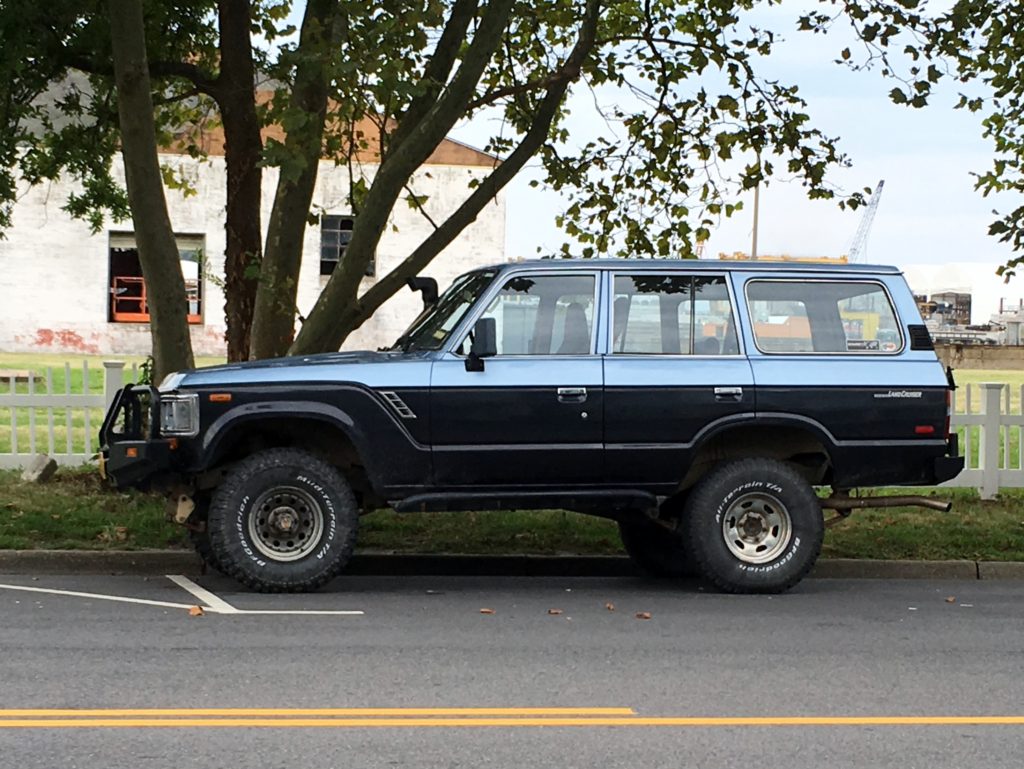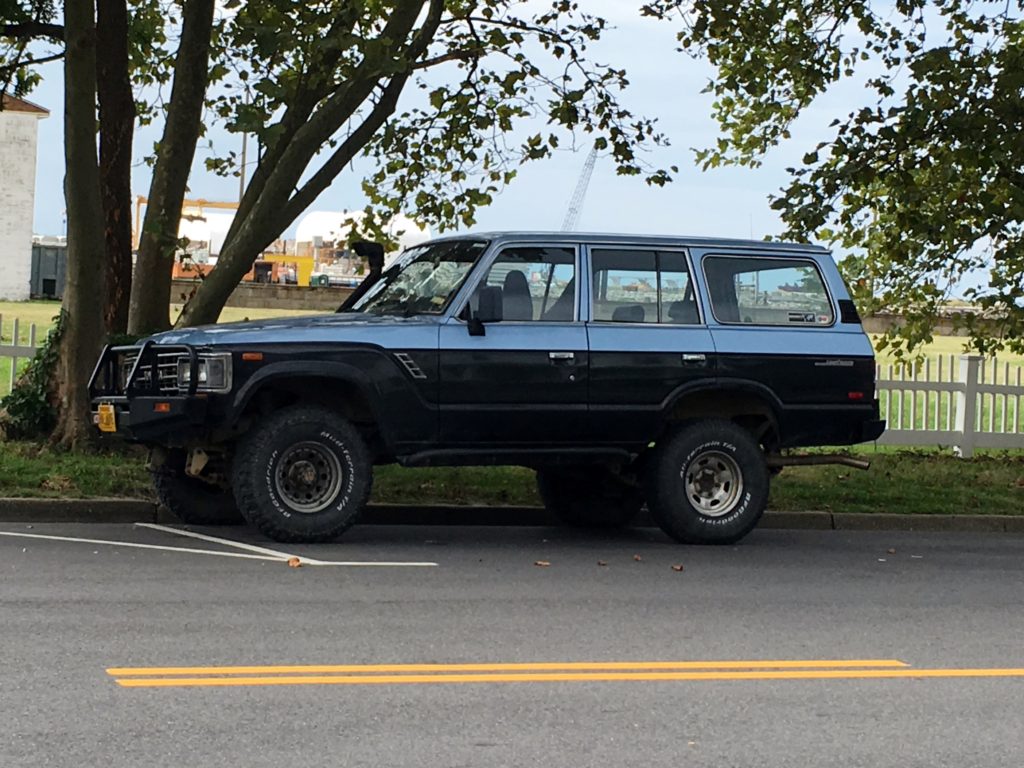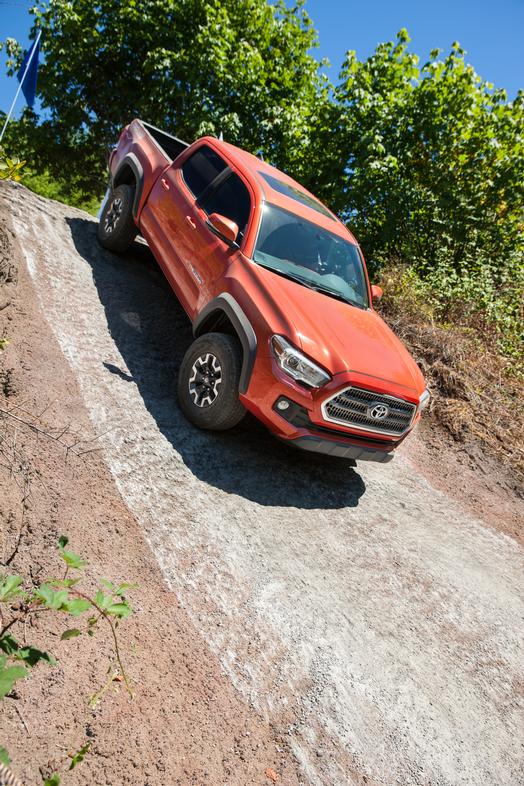
This vintage Toyota Land Cruiser spotted on the Eastern Shore of Virginia looks like a late 1980s FJ62. Two-tone blue, snorkeled, and aside from the mismatched wheels, not bad looking.
You begin to interest me…vaguely
The special commemorative 50th-anniversary issue of the journal Post-Medieval Archaeology is available free online for a limited time via Taylor & Francis:
Table of Contents:
Editorial: ‘The greatest of these is charity’; 50 years of Post-Medieval Archaeology Alasdair Brooks
A short history of the Society for Post-Medieval Archaeology Harold Mytum
The medieval to early modern transition in a digital age: new developments relevant to the study of domestic buildings David H. Caldwell & Catriona Cooper
Globalization and the spread of capitalism: material resonances Audrey Horning & Eric Schweickart
Cities in the modern world
Peter Davies & Greig Parker
The archaeology of industry; people and places Marilyn Palmer & Hilary Orange
The post-medieval rural landscape: towards a landscape archaeology?
Jemma Bezant & Kevin Grant
The material culture of the modern world Mary C. Beaudry & Natascha Mehler
Standing buildings and built heritage
Adrian Green & James Dixon
Where the battle rages: war and conflict in Post-Medieval Archaeology Natasha N. Ferguson & Douglas Scott
The contemporary in post-medieval archaeology Laura McAtackney & Sefryn Penrose
The archaeology of post-medieval death and burial Layla Renshaw & Natasha Powers
Obituary: Lawrence Butler (1934 – 2014)
Harold Mytum
Yet another person concludes that the Toyota Tacoma QuadCab pickup truck is the best (new) vehicle for overlanding.
The Tacoma has been the gold standard for people who want a small off road truck for decades and while the “all new” model leaves a little to be desired in terms of keeping up with the new and strong competition as a whole, its missions specific dominance remains unchallenged. The Tacoma is right blend of capability and cost for maximum value to the overland traveler

Well, this could turn out badly. Hopefully the zooarchaeologist is using hyperbole to encourage Fish and Wildlife to figure out their own rules.
If a “huge” load of scientifically valuable prehistoric animal bones aren’t returned soon to the Museum of the Aleutians, they may end up in the trash in Canada, according to a frustrated scientist in Victoria, British Columbia, who is encountering tax problems while trying to avoid international legal difficulties.
It turns out that the $6,000 set aside for shipping three shrink-wrapped pallets of nearly a half million bones back to Unalaska is causing financial headaches for the private research firm, Pacific Identifications, according to zoologist and treasurer Susan Crockford.
“We had to pay taxes on these funds to carry them forward to this year. We are unwilling to pay taxes on these funds for yet another year,” Crockford said in an email to the U.S. Fish and Wildlife Service. “It means that if we cannot get the import permit required to ship the material by August of this year at the latest, we face having to do something unconscionable to professional archaeologists and research scientists: send all 57 boxes to the dump.”
Most likely, no federal permits are needed, according to Andrea Medeiros, a Fish and Wildlife spokeswoman in Anchorage, since the bones came from Native corporation land, and not federal property, under the terms of the Archaeological Resources Protection Act. However, Fish and Wildlife Service officials were still reviewing the requirements of international treaties involving endangered species and migratory birds.
Read the rest at Alaska Dispatch News
The University of Minnesota is conducting a field school at a historic site in Carver County first occupied in 1855 by Swedish-American farmer Andrew Peterson. Local newspaper the Chaska Herald has a photo essay showing the site and the tools of the trade.

A three-year project at the Utah Division of State History has been completed, according to The Spectrum. Almost 120,000 site records have been digitized.
The Landmarks Preservation Commission of New York City is looking to hire a part-time archaeologist to assist with the review of cultural resource surveys, maintain a website, and assist in other duties.
Standard archaeology job qualifications apply, and New York City residency is required within 90 days. For more details, including pay rate, see the NYC Careers site.
A one-day conference focusing on the Archaeological Curation Crisis in the 21st Century will be held Saturday, April 23 at Marlboro College in Brattleboro, Vermont. The meeting is organized by the Conference on New England Archaeology. For more information, visit the CNEA .
All of the archaeological site reports produced by the Charleston Museum since 1975 are now available for free download.
Charleston Museum Archaeology Reports
From the official press release:
The Charleston Museum is pleased to announce that archaeological site reports, produced by its Archaeology Department, are now available online. Comprising 56 reports, the bulk of which were prepared by Curator of Historical Archaeology Martha Zierden, they cover a variety of Lowcountry projects, including urban, plantation and military sites.
The publication of a site report is the final phase of any archaeological project and contains all of the details of a project, from site history and fieldwork discoveries to enumeration of recovered artifacts. Many reports also include detailed assessments from specialists, who analyzed animal bone, examined soil samples for pollen or parasites, or focused on particular artifact types.
The Museum, which has sponsored a program in historical archaeological research in the Lowcountry since the 1970s, is excited to be able to make this information available to the public, thanks to a recent website upgrade and the efforts of several staff members. Curator of Historical Archaeology Martha Zierden notes “because of their limited production and distribution, site reports are often hard to find. Now decades of research from the Museum are available to everyone.” Director Carl Borick added that these reports “are an invaluable window into the Charleston area’s past, and an excellent example of the dedicated research efforts of Martha Zierden, Ron Anthony, and other staff members, who have made a critical contribution to the Museum’s mission.”